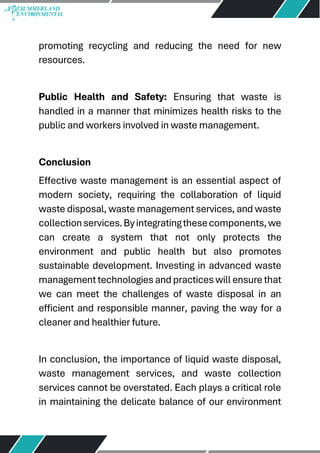Some Known Details About Reclaim Waste
Some Known Details About Reclaim Waste
Blog Article
5 Simple Techniques For Reclaim Waste
Table of ContentsFascination About Reclaim WasteRumored Buzz on Reclaim WasteThe Single Strategy To Use For Reclaim WasteThe Single Strategy To Use For Reclaim WasteIndicators on Reclaim Waste You Need To Know
Explore the types, occurrences, and kinds of liquid waste. Residential sewer waste describes the waste and items from a residential sewage-disposal tank. This kind of waste is produced by people in homes, schools, and other structures. This only consists of sewage-disposal tanks that have a drain field. The proper management and disposal of domestic sewage waste call for liquid waste to be transferred to a sewer treatment plant where the proper techniques and tools are applied to detoxify and deal with waste.
Industrial waste commonly consists of potential dangers, such as flammable materials or a mix of fluid and solid waste products, and requires a more innovative and thorough disposal process. The disposal of business waste usually includes the filtration of waste before transportation to make certain secure and appropriate disposal. Industrial waste is produced from results and overflow of industrial procedures and manufacturing.
This kind of waste can not utilize the exact same sewage management transport or processes as septic or business liquids. The industrial waste monitoring process requires the inspection and screening of fluid waste before it goes through the disposal process (liquid waste removal). Drainage waste is the liquid waste that originates from runoff and excess stormwater in highly booming locations or cities
Overflow waste can create contamination and flooding if not dealt with properly. Making sure proper waste monitoring can avoid calamities and lower environmental damage.
How Reclaim Waste can Save You Time, Stress, and Money.
Get in touch with PROS Services today to find out about our waste management and disposal solutions and the appropriate methods to take care of the fluid waste you generate.
(https://forums.hostsearch.com/member.php?271151-reclaimwaste1)Do you know what happens to your water when you end, purge the commode or drain pipes the cleaning equipment? No? Well, it's worth knowing. This supposed 'wastewater' is not only a crucial source but, after treatment, will certainly be launched to our land, waterways or the sea. Used water from toilets, showers, bathrooms, kitchen area sinks, laundries and industrial procedures is called wastewater.

water utilized to cool equipment or tidy plant and equipment). Stormwater, a form of wastewater, is overflow that flows from agricultural and urban locations such as roofing systems, parks, yards, roads, paths and gutters into stormwater drains pipes, after rainfall. Stormwater moves without treatment directly to local creeks or rivers, eventually getting to the sea.
Getting The Reclaim Waste To Work
In Queensland, a lot of wastewater is dealt with at sewage treatment plants. Wastewater is delivered from domestic or commercial websites via a system of drains and pump terminals, known as sewerage reticulation, to a sewage treatment plant. Local governments develop, maintain and operate most sewage therapy plants. Operators are accredited under the Environmental Management Act 1994 to release treated wastewater at an appropriate ecological criterion right into rivers.
The Department of Natural Resources advises city governments concerning managing, operating and preserving sewerage systems and treatment plants. In unsewered locations, regional governments may call for owners to mount individual or household sewage treatment systems to treat residential wastewater from toilets, kitchens, restrooms and washings. The Department of Natural Resources authorises making use of family systems when they are confirmed to be efficient.
A lot of stormwater obtains no treatment. In some brand-new class, therapy of some stormwater to get rid of trash, sand and crushed rock has started utilizing gross contaminant catches. Wastewater treatment happens in 4 phases: Gets rid of solid issue. Bigger solids, such as plastics and various other things wrongly released to sewage systems, are gotten rid of when wastewater is travelled through displays.
Utilizes small living organisms understands as micro-organisms to break down and get rid of remaining liquified wastes and fine particles. Micro-organisms and wastes are integrated in the sludge.
The Ultimate Guide To Reclaim Waste
Nutrient removal is not readily available at all sewer therapy plants since it requires pricey specialist devices. Clear fluid effluent generated after treatment may still contain disease-causing micro-organisms - liquid waste removal melbourne.

This generally means wastewater needs to be dealt with or contaminants removed prior to it can be released to rivers. The majority of wastewater moves right into the sewerage system. Under the Act, neighborhood federal governments carry out approvals and licences for environmentally appropriate tasks (ERAs) including wastewater releases that could have a neighborhood impact. The division administers authorizations and licences to ERAs including wastewater releases that may have a local or statewide effect.
The 8-Second Trick For Reclaim Waste
Otherwise, samples are considered lab evaluation. Commonly many tests are needed to establish the degrees of each of the various contaminants such as oils, hefty metals and chemicals in water. Tracking provides valid information concerning water quality and can validate that licence conditions are being satisfied. The details gotten through tracking offers the basis for making water high quality decisions.
Report this page